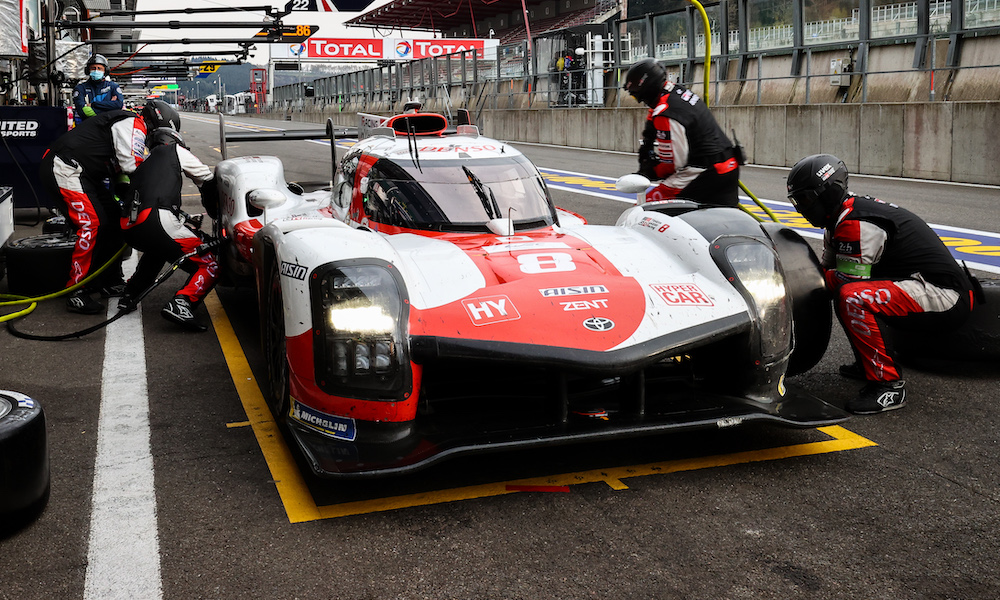Toyota Gazoo Racing technical director Pascal Vasselon described the first race for the new Toyota GR010 Hybrid Le Mans Hypercar as a “hectic” affair with several teething issues despite the manufacturer claiming a landmark chapter-opening victory at Spa.
After Sebastien Buemi, Brendon Hartley and Kazuki Nakajima won the 2021 FIA World Endurance Championship season-opener in the new Hypercar class, Vasselon admitted that the six-hour contest was “not a totally great” race from a technical perspective.
Issues impacted both Toyotas, with the No. 8 needing to fight back from an early penalty caused by a refueling hose connection time error and the No. 7 encountering several setbacks including repeated lock-ups into corners and a system reset in the final hour.
The No. 7, which arrived at Spa as a new chassis, also experienced hydraulic and electrical issues earlier in the week which limited its mileage during the Prologue pre-season test.
It found pace approaching the end of the week in the hands of Kamui Kobayashi, who took pole position by half a second, but it went on to endure a challenging opening race.
The front locking problem resulted in a handful of incidents, including Jose Maria Lopez tapping the No. 91 Porsche Porsche 911 RSR-19 which sealed a Toyota drive-through, and Kobayashi running deep into the Bruxelles gravel which cost him the lead in hour five.
“What was positive for us is that the two cars are at the end,” reflected Vasselon.
“After the issue we had with car No. 7 on day one of the Prologue, it’s good that we have the two cars at the end of the first race.
“What has not been great is that we have had several mistakes, especially in the first pit stops. We have had the car No. 7 engine not restarting properly.
“We have had car No. 8 refueling too short on the first refuel, so we had to self-impose a penalty at the second pit stop.”
That penalty was a 36.5-second stop-hold, calculated as the amount of time gained by undercutting the minimum refuel time, multiplied by four and with five seconds added.
The minimum refuel time at all Hypercar refueling stops except the last was 35 seconds multiplied by the sum of dividing the amount of energy used in the previous stint with the total maximum stint energy allowance, which stood at 964 MJ for the Toyotas at Spa.
“What happened is that our refueler – who is extremely experienced and has spent more than 10 years with a kind of automatism – when he sees the fuel coming up, he knows that he has to look at the timer,” said Vasselon.
“But instinct took over, and when the fuel came up he released. He tried to go back, but obviously the car was gone.”
While the No. 8 car was losing its early lead to that penalty, the No. 7 also had a slow second stop due to a gearbox oil top-up which enabled Alpine to lead at halfway.
“We have had a drop of oil pressure which is still to be explained,” said Vasselon. “So we re-filled a bit of oil and it was all OK.”
As the No. 7 went on to have more issues, particularly with front-wheel locking, the No. 8 was given a five-second stop-hold penalty during the fourth hour after Toyota was deemed to have unsafely released the car from its pit box into the path of an LMP2.
Vasselon accepted the penalty, which ultimately didn’t affect the outcome of the result, but said that no blame was to be attached to a member of the Toyota crew.
“It was not the fault of our lollipop man,” he said. “He did a good job, but the car had a hesitation, something like half a second.
“And the LMP2 has had a really brilliant start, and then he has had to brake.
“The unsafe release was logical, but not the fault of the lollipop man. The engine has had a hesitation to start. Quite a lot of smallish issues, but it has been quite hectic.”
Regarding the No. 7 car’s lock-up issues, Vasselon said: “There was a sensitiveness on front-wheel locking on that car. We have to analyze because normally they can play with the brake balance, so it’s something which they can change on the system in the car.”
Quick FCY Pit Decision Teed Up Victory
Although Toyota found itself being pushed hard for the win by Alpine, the reigning WEC champion squad managed to overcome its only Hypercar competition through strategy.
Toyota decided to bring Nakajima into the pits during the second Full Course Yellow of the race, caused by Kobayashi’s slide out of the lead at Bruxelles early in the fifth hour.
By pitting Nakajima only halfway into his stint, Toyota positioned its No. 8 car to complete the race on one more pit stop even if there were no further FCY interruptions.
At that time, Alpine needed two more stops from its ORECA-built LMP1 car.
“It’s important for us to win the first Hypercar race, so we are happy about that,” said Vasselon.
“Just that it has been hard work. We have had a very good strategy call towards the end to take the Full Course Yellow. We were just marginally good [on fuel].
“We had to do fuel saving for the last part of the race. We were normally doing 25 laps, but we caught the Full Course Yellow and had to do 26 laps two times.
“This is what gave us the win because it saved us one stop. It was a really good strategy call from our strategist. This is how we won.”



























